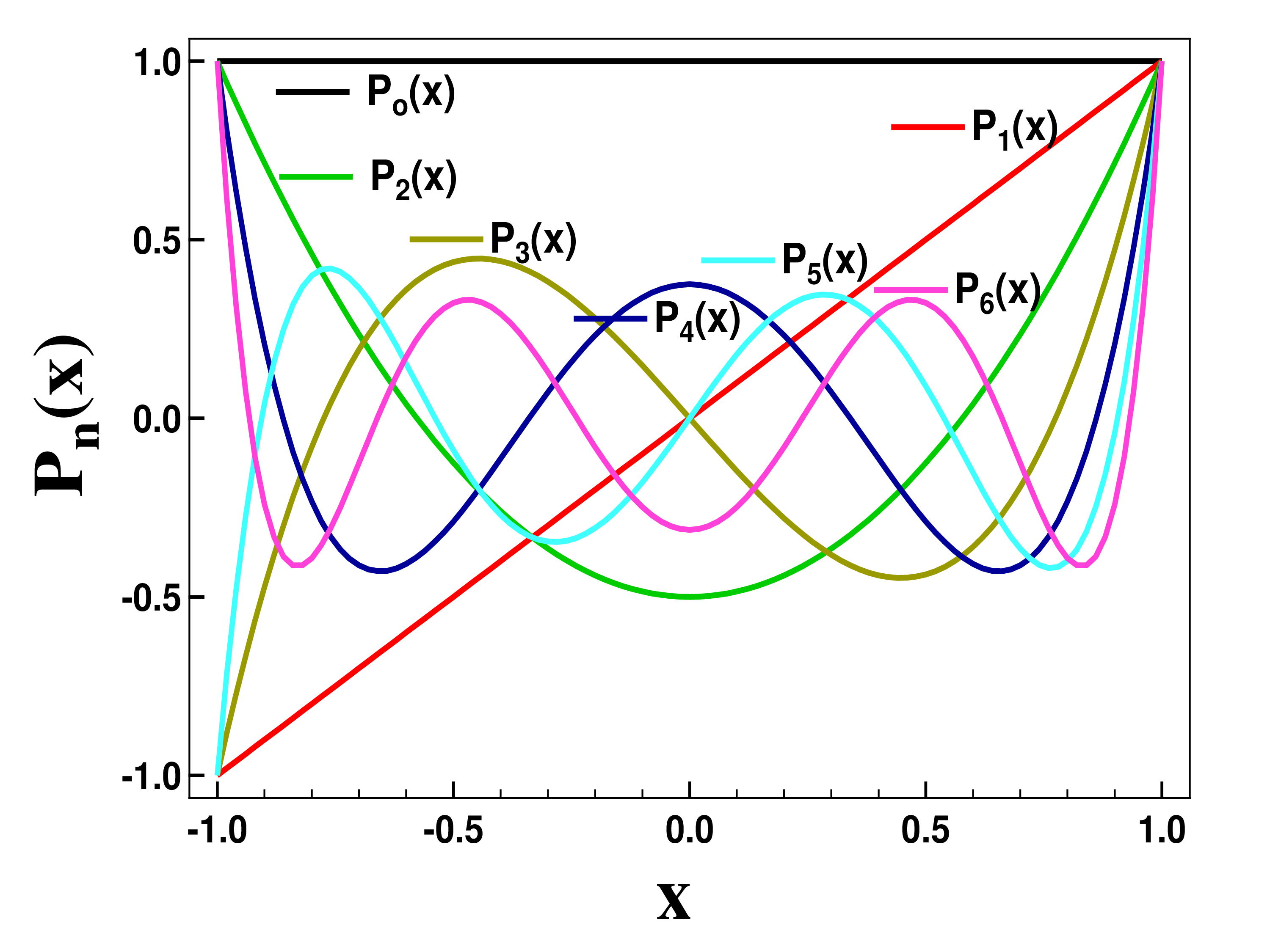Let
\begin{equation}
v=(x^{2}-1)^{n}\tag{4.5.14}
\end{equation}
then,
\begin{equation*}
\frac{\,dv}{\,dx}=n(x^{2}-1)^{n-1}\cdot2x =\frac{n(x^{2}-1)^{n}}{(x^{2}-1)}\cdot 2x
\end{equation*}
or,
\begin{equation*}
(x^{2}-1)\frac{\,dv}{\,dx}=2n(x^{2}-1)^{n}x
\end{equation*}
or,
\begin{equation}
(x^{2}-1)\frac{\,dv}{\,dx} =2nvx\tag{4.5.15}
\end{equation}
Now, differentiating equation (4.5.15), \((n+1)\) times using Leibnitz theorem, we get -
\begin{equation*}
(x^{2}-1)\frac{d^{n+2}}{dx^{n+2}}v + \comb{n+1}{1} (2x)\frac{d^{n+1}}{dx^{n+1}}v+\comb{n+1}{2} (2)\frac{d^{n}}{dx^{n}}v
\end{equation*}
\begin{equation*}
=2n\left[x \frac{d^{n+1}}{dx^{n+1}}v+\comb{n+1}{1}(1)\frac{d^{n}}{dx^{n}}\right].
\end{equation*}
or,
\begin{equation*}
(x^{2}-1)\frac{d^{n+2}}{dx^{n+2}}v +2x\left[\comb{n+1}{1} -n\right]\frac{d^{n+1}}{dx^{n+1}}v
\end{equation*}
\begin{equation*}
+2\left[\comb{n+1}{2} -n \comb{n+1}{1}\right]\frac{d^{n}}{dx^{n}}v=0
\end{equation*}
or,
\begin{equation}
(x^{2}-1)\frac{d^{n+2}}{dx^{n+2}}v +2x \frac{d^{n+1}}{dx^{n+1}}v-n(n+1)\frac{d^{n}v}{dx^{n}}=0\tag{4.5.16}
\end{equation}
If we put \(\frac{d^{n}v}{dx^{n}}=y\) then equation (4.5.16) becomes
\begin{equation*}
(x^{2}-1)\frac{d^{2}y}{dx^{2}} +2x \frac{dy}{dx}-n(n+1)y=0
\end{equation*}
or,
\begin{equation}
(1-x^{2})\frac{d^{2}y}{dx^{2}} -2x \frac{dy}{dx}+n(n+1)y=0. \tag{4.5.17}
\end{equation}
which is Legendre’s equation and \(y= \frac{d^{n}v}{dx^{n}}\) is one of its solution.
\begin{equation}
\therefore P_{n}(x)=C\frac{d^{n}v}{dx^{n}}\tag{4.5.18}
\end{equation}
where C is a constant. But,
\begin{equation*}
v=(x^{2}-1)^{n}=(x+1)^{n}(x-1)^{n},
\end{equation*}
so that
\begin{equation*}
\frac{d^{n}v}{dx^{n}}=(x+1)^{n}\frac{d^{n}}{dx^{n}}(x-1)^{n}+\comb{n}{1}n(x+1)^{n-1}\frac{d^{n-1}}{dx^{n-1}}(x-1)^{n}
\end{equation*}
\begin{equation*}
+\cdots+(x-1)^{n}\frac{d^{n}}{dx^{n}}(x+1)^{n}.
\end{equation*}
when \(x=1\text{,}\)
\begin{equation*}
\frac{d^{n}v}{dx^{n}}=2^{n}n!
\end{equation*}
All the other terms disappear as \((x-1)\) is a factor in every term except first.
Therefore, when \(x=1\text{,}\) equation (4.5.18) gives
1
\begin{equation*}
\because \frac{d^{n}}{dx^{n}}(x-1)^{n}=n! ;
\end{equation*}
\begin{equation*}
\frac{d^{n-1}}{dx^{n-1}}(x-1)^{n}=n(x-1)\cdots 2(x-1);
\end{equation*}
\begin{equation*}
\frac{d^{n-2}}{dx^{n-2}}(x-1)^{n}=n(x-1)\cdots 3(x-1)^{2}
\end{equation*}
\begin{equation*}
P_{n}(1) = C\cdot 2^{n}n!=1 \quad \therefore C =\frac{1}{2^{n}n!}
\end{equation*}
Hence,
\begin{equation*}
P_{n}(x) = \frac{1}{2^{n}n!}\frac{d^{n}v}{dx^{n}}
\end{equation*}
from equation (4.5.18).
\begin{equation*}
\therefore \quad P_{n}(x) = \frac{1}{2^{n}n!}\frac{d^{n}}{dx^{n}}(x^{2}-1)^{n}
\end{equation*}
from equation (4.5.14). This is the Rodrigue’s Formula for Legendre Polynomial.

